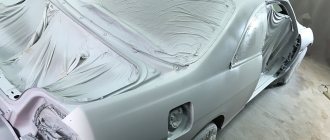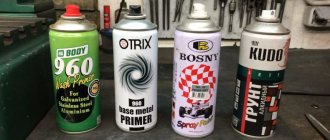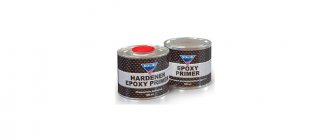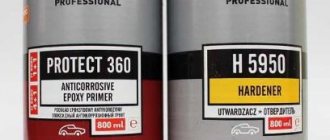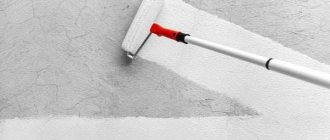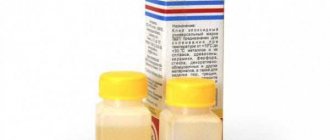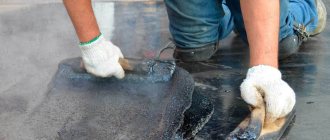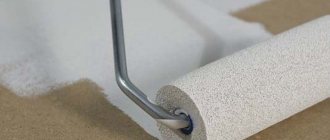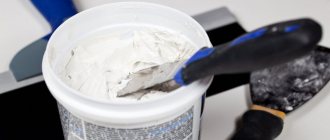An epoxy-based primer is a type of paint material that protects the metal base of the surface from corrosion. This is possible due to the presence of the following components: special resins and chemically active additives.
Their presence in the composition of the material prevents the development of a destructive process on surfaces made of metal. Epoxy primer is produced in a can (in the form of an aerosol) and in steel containers of various sizes. Today we’ll talk about where this material is used, what its technical characteristics are, and we’ll also learn the technology for preparing the composition.
What is the difference between acid primer and epoxy primer?
Epoxy primer is a substance that includes epoxy resin, fillers, polymers, and some alcohol derivatives. The primer, after application, creates a film that does not allow oxygen to pass through. After hardening, the soil does not allow water to penetrate at all, since it does not form pores. Epoxy primer is available in a can or in jars.
Epoxy primer in cans Source sevparitet.ru
Epoxy Primer Differences
According to experts, epoxy primer should be applied directly to clean metal and then putty. This is especially important if the metal is being restored over several weeks, i.e. for a long time.
For example, if a car sits in a garage for a long time, then, since there is humidity in the room, the areas of the body that have been stripped down to metal will begin to oxidize. In this case, you can choose the option of puttying with an epoxy primer. Then the putty should be applied before the primer has completely hardened.
Differences in acid soil
When it comes to acidic soil, you can hear the following names: phosphating, etching, reactive. The primer in this embodiment is a compound of zinc and phosphoric acid. More precisely, it consists of:
- polyvinyl butyral, which is a synthetic material and serves to form good adhesion and film;
- zinc phosphates and chromates;
- water;
- phosphoric acid, which is an excellent rust converter;
- alcohol.
Composition of acidic soil Source strport.ru
The operating principle is approximately this: phosphoric acid acts on the metal and, at the same time, zinc is precipitated. The film is formed by polyvinyl butyral - the acrylic layer will already adhere tightly to it. After applying the primer to the metal surface, a thin coating is obtained. It is an anti-corrosion and adhesive layer. The primer does not completely destroy the rust that is already there, but it also does not allow it to spread.
Acid primer for cars is divided into four main types:
- One-component.
Acid primer is often sold in a can to make processing easier. You can also use a can of primer to spray it with a spray gun. The composition does not need to be prepared - it can be used immediately. When the soil hardens, you can begin to treat it with an acrylic composition to which a hardener has been added.
- Two-component.
If you purchase a two-component primer, you must prepare a primer. To do this, it is mixed with an activator, and the consistency can be different - hard or soft.
Two-component primer Source autocosmetica.by
See also: Catalog of companies that specialize in paints and varnishes.
Professionals prefer to work with a solid form, as it gives the strongest film. Depending on the recommendations in the instructions, the two-component composition can be applied in 1, 2, 3 layers. During treatment, maintain an interval of approximately 5 minutes between applications.
- Reactive.
This option is used for clean surfaces. The reactive substance forms a very small layer (8-13 microns). This is the base on which the following layers should be applied.
- Self-Etching primer.
This substance is a soil with the addition of zinc. Used to eliminate unevenness and improve the quality of adhesion. The substance acts on the metal, resulting in the creation of a layer of frozen polymer elements.
Self-Etching primer Source alicdn.com
You can choose a one- or two-component primer, but most craftsmen use a material that has two ingredients. The greatest wear resistance is achieved through filler primer - this is a necessary stage of coating.
Base requirements
Recommended types of bases: new or old concrete or cement-sand screeds, self-leveling cement masses.
Work on the installation of a polymer coating must be carried out no earlier than the base reaches 70% of its brand strength and its mass humidity is no more than 4% (as a rule, this happens 28 days after installation).
In the design of the base of a concrete floor on the ground, a waterproofing layer must be provided and properly executed. This rule is also mandatory in the construction of the base on the floor slab, when there are humid processes or temperature changes in the rooms below. Capillary rise of moisture in the substrates is not allowed - this can lead to peeling of the polymer coating.
All contaminants (cement laitance, oil stains, putty and paint residues) must be completely removed, as they affect the adhesion and penetrating ability of the material.
The compressive strength of the base must be at least 20 MPa (about 200 kgf/cm2). Peel strength is not less than 1.5 MPa.
The evenness of the base is determined by the requirements and operating conditions. Also, the permissible values of base slopes depend on the selected polymer coating system. As a rule, the horizontal deviation in flatness should not exceed 4 mm on a 2-meter rail.
Substrate defects (cracks, voids, delaminations and weakened areas) must be repaired before applying the polymer coating.
Advantages and disadvantages
The properties of an acid primer are considered its advantages. These include:
- high degree of wear resistance;
- enormous resistance to moisture and salt compounds;
- reliable protection of the material from external negative influences;
- excellent heat resistance – at high temperatures the qualities of substances do not change;
- fast hardening – within 5 minutes;
- resistance to the destructive aggressive influence of petroleum products, such as engine oils and gasoline.
In addition to numerous advantages, there are also disadvantages of the material. For example, it burns well. In addition, it is toxic, and when working with it you must work carefully and avoid contact with the skin and eyes.
When working with acid primer, protective equipment is required Source www.landspeedauto.com
Security measures
Certificates and technical documentation that accompany the substance when purchased by the client warn him of its high toxicity. That is why you should use the following recommendations:
- Do not allow the epoxy primer to come into contact with fire to avoid fire;
- Work with the substance only with rubber gloves;
- Avoid getting the solution into your eyes using special glasses;
Also, clients are recommended to use respirators. Increased toxicity can damage the mucous membrane and walls of the respiratory tract, causing irritation, so it is better to take advice to ensure your own safety.
Stamps
The choice of the optimal acid primer directly depends on the characteristics of the surface being treated. The most popular are:
- DUR 1:1 . Reactive primer with phosphate. High-strength reliable coating with good adhesive ability. The big advantage is that it does not contain chromates. A special reaction catalyst is included with the primer to speed up curing.
- Body 960 Wash primer . Can be used on any surface. Contains 2 components. When used, mix with hardener. After coating the surface, no sanding is required, only a leveling layer, with the exception of polyester. Has a yellow color.
Body 960 Wash primer Source ad-cd.net
- Mobinel . One-component. Characterized by good anti-corrosion properties. Used for aluminum, galvanized, stainless steel. Available in grey.
- Radex CR 1+1 . The primer perfectly etches the metal, reliably protecting it from corrosion. The composition contains liquid and hardener. It has excellent anti-corrosion properties and good adhesion.
- Reoflex 2K 1+1 . Two-component yellow primer. Contains a phosphoritating ingredient and a hardener. Excellent for restoring damaged coatings.
It is better to choose the appropriate option with the help of a specialist.
Concrete protection
To treat concrete surfaces, an epoxy primer for concrete floors and walls is used, for example, pci epoxigrund 390. This type has the following classification:
- quick primers. This type of epoxy primer polymerizes very quickly and contains no solvents;
- universal primers are used as a protective coating before pouring self-leveling floors;
- winter primer solutions are specially made for use in frosty conditions. This epoxy floor primer can withstand temperatures below zero without problems;
- anti-corrosion mixtures.
What primer is best to use?
If the surface of the body panel is clean and free of rust, then an epoxy primer will do just fine. In addition, if the metal has old paint, putty, or primer, then this option is also more suitable.
If there is rust on the surface, then in this case, acidic soil is indispensable. But it is very important to remove as much rust as possible before starting priming. If corroded areas remain, the etching primer will transform and stop the further spread of rust.
There are users who have found it best to prime the surface with an acid primer first and then spray with an epoxy primer. They believe that metal protection is maximized. However, this is absolutely false. The fact is that the epoxy primer, containing a solvent, neutralizes the properties of the etching agent. This leads to the conclusion that only one type of primer should be used for priming the body panel.
Acid and epoxy primers are not used simultaneously Source besplatka.ua
Types of compositions using epoxy
Like other representatives of epoxy composites (adhesives, etc.), epoxy primer for metal, based on certificates, must be sold on the basis of a composition of two components, which are prepared under production conditions before use by the client.
An exception would be compounds that are intended for pre-coating cars. Many companies that make primer come in the form of an aerosol can. Although this method has many advantages, car owners note a low effect from operation.
The reason is slow drying. If you use classic application, the coating hardens faster. That is why the use of any cans of epoxy primers can bring the desired effect only for short-term use of a car or other metal objects.
The primer documentation usually indicates the area of effective application of the product. Compositions based on epoxy substances are distinguished according to the following indicators:
- Pour point - elevated or room temperature;
- Hardener substance. To achieve a minimum level of toxicity to humans, polyamides are used, but some manufacturers use other substances;
- Surface material to be applied. In our case, the product is used for metal, but compositions for concrete are isolated;
- Compatible with paints and varnishes. Primers must have a high level of adhesion to paints and enamels due to the use of polyurethane.
For metal, a specialized epoxy primer is usually used, which hardens at room temperature and interacts well with paints and varnishes.
Primer in cans
Aerosol primer for priming metal coatings has a number of obvious advantages:
- ease of use;
- ensuring uniform spraying of the material over the entire surface;
- suitable for any surface.
Primer in cans is more suitable for local application to metal. When processing large areas, it is better to use a pneumatic gun. Spray primer is great for beginners who have never painted metal parts before. Using an aerosol, paint and varnish materials can be easily leveled, since the application is smooth and beautiful.
Disadvantages of polyurethane coating
One of the main inconveniences in working with primer is the peculiarities of its application. In construction, traditional, combined or airless spraying is used. The traditional method is to apply the primer using compressed air through a spray gun. Material losses with this method can be up to 30%. To reduce them, we recommend using a high-pressure sprayer or airless method. This way you can control the amount of material applied and the angle of distribution.
It is worth noting the relatively high price of polyurethane primer in contrast to anti-corrosion, alkyd and modified alkyd resins.
Briefly about the main thing
An acid primer has a special purpose, which differs significantly from the tasks of acrylic and epoxy primers. It is used exclusively for primary processing, which significantly enhances the protection of metal from rust. Due to chemical protection, the paintwork is used for a long time without the formation of swelling, cracks and other defects.
Thanks to a layer of acid primer, metal surfaces, be it a car, a fence or a galvanized roof, will not be affected by rain, snow or other negative influences. For a long time they will have an attractive appearance and please the eye. The main thing is to understand the types of primer, choose the right one and apply it correctly to the surface.
Ratings 0
Recommended coating designs based on QTP 1000 composition
| Padding | Consumption*, kg/m2 |
| QTP 1000 (per 1 layer) | 0,25 – 0,35 |
| Primer putty (thickness ~0.5 mm) | Consumption for thickness 0.5 mm, kg/m2 |
| QTP 1000 (1 part by weight) Quartz sand 0.1-0.4 mm (1 part by weight) | 0,39 0,39 |
* Actual costs at the site may differ from the above data due to different porosity of the base, surface roughness, qualifications of performers and other factors.
Temporary breaks between layers
| Temperature | +10оС | +20оС | +30оС |
| Time Minimum | 12 hours | 6 hours | 5 o'clock |
| Time Maximum | 36 hours | 24 hours | 12 hours |
Curing time
| Temperature | +10оС | +20оС | +30оС |
| You can walk | 12 hours | 6 hours | 4 hours |
| Light load | 3 days | 2 days | 1 day |
| Full load | 6 days | 5 days | 4 days |
